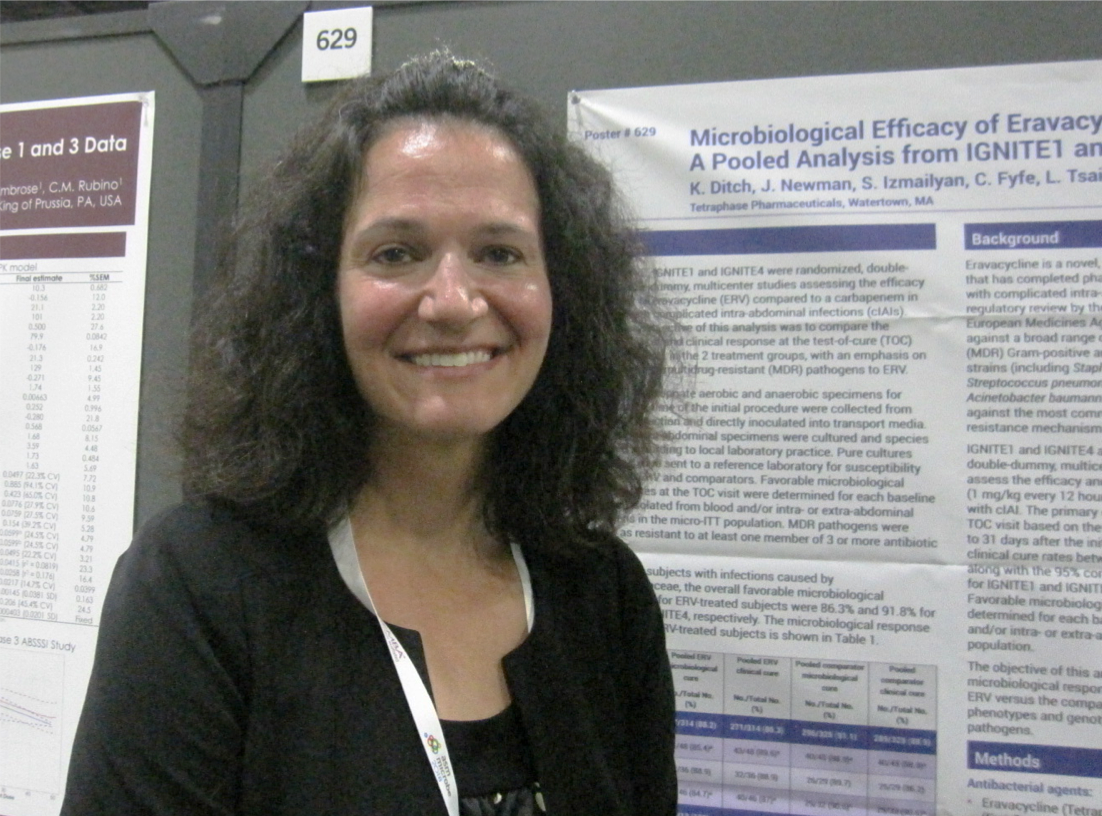Pooled IGNITE 1 and 4 Results Reinforce the Efficacy and Safety of Eravacycline for Complicated Intra-abdominal Infections
The pooled results have hammered home the promise of eravacycline for the treatment of patients with cIAIs who are colonized by drug-resistant bacteria.

Kristen Ditch, PharmD, stands next to her poster at ASM Microbe 2018.
A pooled analysis of the findings from the Investigating Gram-Negative Infections Treated with Eravacycline (IGNITE 1; NCT01844856) and IGNITE 4 (NCT01978938) phase 3, randomized, double-blind trials has confirmed the non-inferiority of eravacycline compared to the carbapenem class of antibiotics in the treatment of complicated intra-abdominal infections (cIAIs).
“In the IGNITE 1 and IGNITE 4 studies, eravacycline demonstrated excellent clinical cure rates for commonly observed Gram-negative pathogens. Favorable microbiological and clinical responses were observed for eravacycline against Enterobacteriaceae and Acinetobacter baumannii (A baumannii) Gram-negative pathogens that were third- and fourth-generation cephalosporin-resistant, [extended spectrum β-lactamase]-producing, or multi-drug resistant,” said 2018 ASM Microbe meeting poster presenter Kristen Ditch, PharmD, a Medical Science Liaison with Tetraphase Pharmaceuticals, the developer of eravacycline.
The pooled results have hammered home the promise of eravacycline for the treatment of patients with cIAIs who are colonized by drug-resistant bacteria and puts the finishing touch on the pending application for approvals to the US Food and Drug Administration (FDA) and the European Medicines Agency (EMA).
The main aims of this pooled analysis were to compare the clinical response in terms of the obliteration of the infection, which is termed microbiological cure, and the absence of symptoms, which is termed clinical cure. The pooled analysis focused on multidrug-resistant Enterobacteriaceae and A baumannii, given their prevalence and clinical importance in cIAIs.
The pooled microbiological and clinical cures achieved using eravacycline were 88.2% and 86.3%, respectively, for Enterobacteriaceae. Both rates were 100% against A baumannii. The rates for the comparator antibiotics (ertapenem in IGNITE 1 and meropenem in IGNITE 4) were 91.1% and 88.9%, respectively, for Enterobacteriaceae, with both rates being 100% for A. baumannii.
Parsing out the data in terms of isolates that were cephalosporin-resistant, ESBL-producing, or multidrug-resistant yielded similar rates.
In IGNITE 1, 541 patients with cIAI were randomized to receive intravenous (IV) treatment with either eravacycline 1.0 mg/kg every 12 hours (n = 270) or the carbapenem antibiotic, ertapenem, 1.0 g every 24 hours (n = 271) for at least 4, 24-hour cycles. The primary endpoint was cure rates after about 1 month. The clinical cure was 86.8% and 87.6% in the eravacycline and ertapenem groups, respectively. The smidgen difference met the benchmark for statistical noninferiority (JAMA Surg 152: 224-232 2017).
In IGNITE 4 (NCT02784704), which has not yet been published, eravacycline was matched up against another carbapenem, meropenem. A total of 499 patients with cIAIs were randomized to IV treatment with eravacycline 1.0 mg/kg twice-daily (n = 250) or meropenem 1 g every 8 hours (n = 249). The clinical cure rates evaluated about 1 month after the start of the treatments were comparable for eravacycline and meropenem whether evaluated according to the criteria set out by the FDA (90.8% vs 91.2%) and EMA (92.4% vs 91.6%). Again, eravacycline was statistically noninferior to the comparator.
Treatment-related adverse events were similar between the antibiotics in both trials, and often included nausea and vomiting. These occurred in fewer than 5% of the patients. Serious adverse events were not a concern.
The individual results of the 2 trials and the present pooled analysis are the basis for approval submissions that have been made to the FDA and EMA.
Eravacycline is a novel, fully synthetic fluorocycline antibiotic of the tetracycline class. In vitro tests have demonstrated its activity against a raft of clinically important bacteria, including gram-negative and -positive strains that require oxygen for growth or which can grow in the absence of oxygen locales. Importantly, the antibiotic can kill bacteria that cannot be killed by cephalosporins, fluoroquinolones, and β-lactam antibiotics. This impressive list of targets includes multidrug-resistant strains, carbapenem-resistant Enterobacteriaceae, and most anaerobic pathogens.
The study was funded by Tetraphase Pharmaceuticals
DISCLOSURES
Kristen Ditch; Employee, Tetraphase Pharmaceuticals
PRESENTATIONS
Kristen Ditch; Tetraphase Pharmaceuticals, Watertown, MA
SATURDAY-629
Abstract Title:
Microbiological Efficacy of Eravacycline against Enterobacteriaceae And Acinetobacter, Including Mdr Isolates: A Pooled Analysis from Ignite1 and Ignite4, Two Phase 3 Trials of Complicated Intra-Abdominal Infection
Brian Hoyle, PhD, is a medical and science writer and editor from Halifax, Nova Scotia, Canada. He has been a full-time freelance writer/editor for over 15 years. Prior to that, he was a research microbiologist and lab manager of a provincial government water testing lab. He can be reached at hoyle@square-rainbow.com
